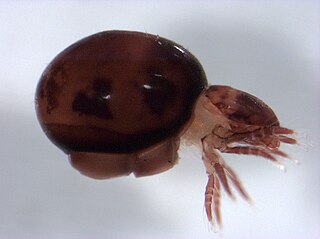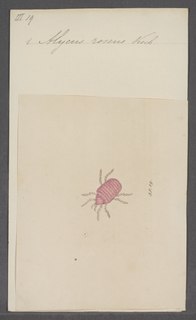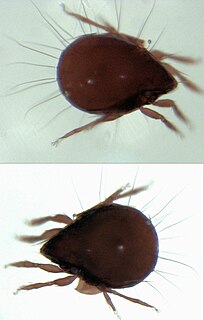
Oribatida, also known as oribatid mites, moss mites or beetle mites, are an order of mites, in the "chewing Acariformes" clade Sarcoptiformes. They range in size from 0.2 to 1.4 millimetres. There are currently 12,000 species that have been identified, but researchers estimate that there may anywhere from 60,000 to 120,000 total species. Oribatid mites are by far the most prevalent of all arthropods in forest soils, and are essential for breaking down organic detritus and distributing fungi.
Plateremaeidae is a family of oribatids in the order Sarcoptiformes. There are about 7 genera and 19 described species in Plateremaeidae.

Alycidae is a family of mites, or endeostigs, in the suborder Endeostigmata. There are at least 6 genera in Alycidae.

Avenzoariidae is a family of feather mites in the order Astigmata. There are at least 15 genera in Avenzoariidae. They are found on the feathers of aquatic birds, and in the case of one species, birds of prey.
Freyanidae is a family of feather mites in the order Astigmata. There are more than 15 genera in Freyanidae.
Algophagidae is a family of mites in the order Astigmata. There are about 5 genera and at least 10 described species in Algophagidae.
Scutoverticidae is a family of oribatids in the order Oribatida. There are about 8 genera and at least 50 described species in Scutoverticidae.

Phthiracaridae is a family of oribatid mites in the order Oribatida. There are about 7 genera and at least 710 described species in Phthiracaridae.

Caeculidae is a family of mites in the order Trombidiformes, the only family of the superfamily Caeculoidea. There are about 6 genera and more than 30 described species in Caeculidae, found in North America, Australia, and southern Africa. The oldest records of the family are from the Cenomanian aged Burmese amber, belonging to the extant genus Procaeculus.
Limnocharidae is a family of mites in the order Trombidiformes. There are at least 4 genera and about 12 described species in Limnocharidae.

Hydryphantidae is a family of mites in the order Trombidiformes. There are more than 30 genera and 130 described species in Hydryphantidae.

Cocceupodidae is a family of mites in the order Trombidiformes. There are at least 3 genera and about 23 described species in Cocceupodidae.

Neotrombidiidae is a family of velvet mites and chiggers in the order Trombidiformes. There are at least four genera in Neotrombidiidae.

Trombidioidea is a superfamily of mites in the order Trombidiformes. There are about 8 families and at least 430 described species in Trombidioidea.

Hypochthonius is a genus of mites in the family Hypochthoniidae. There are about 10 described species in Hypochthonius.

Enarthronota is a suborder of mites in the order Oribatida. There are about 14 families and more than 450 described species in Enarthronota.
Mochloribatula is a genus of mites in the family Mochlozetidae. There are about eight described species in Mochloribatula.

Oripodoidea is a superfamily of oribatids in the order Oribatida. There are about 19 families and at least 1,300 described species in Oripodoidea.
Exochocepheus is a genus of mites in the family Scutoverticidae. There are about seven described species in Exochocepheus.
Licneremaeoidea is a superfamily of mites in the order Oribatida. There are about 6 families and more than 170 described species in Licneremaeoidea.










